
The tradition of river descending is very long in some Czech towns.
Fig. 14 Historical footage voyage

Fig. 15 Floating wood
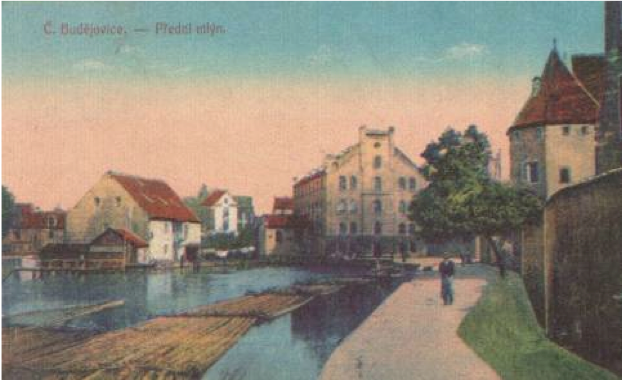
Fig. 16 Canoe as a means of transport
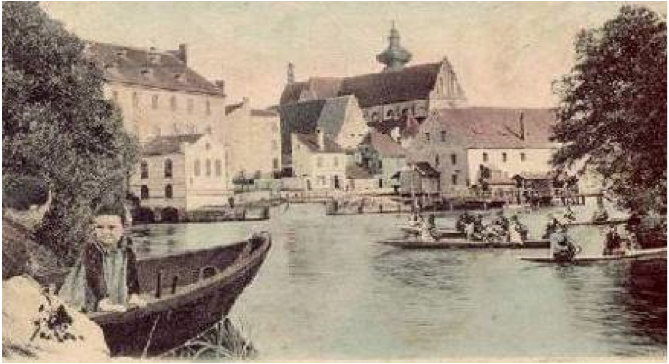
The original inhabitants of Canada and Greenland used kayaks and canoes as early as six thousand years ago as a means of transport on seas, lakes and rivers. On North American rivers, the Indians used wooden canoes with birch wood planking. A traditional vessel of the Inuit has been a kayak spread with sea-calf skin. Pacific islanders used canoes hollowed from a tree trunk. At the beginning of the 19th Century, canoes were also used by white people, mainly for exploration purposes. The figure at the bottom center depicts the expedition led by Archibald McDonald when descending the canyon of the Frazer River in Canada in 1828, and Bear River in Nova Scotia. As a sport, canoeing appeared in the 19th Century. It was, however, speed canoeing. In 1865, the first Canoe Club was founded in London. For a long time, Indian ribbed canoes were a template for manufacturing sports canoes. For planking, however, more modern materials were used than the original birch wood (bottom right).
Fig. 17 Archibald McDonald expedition
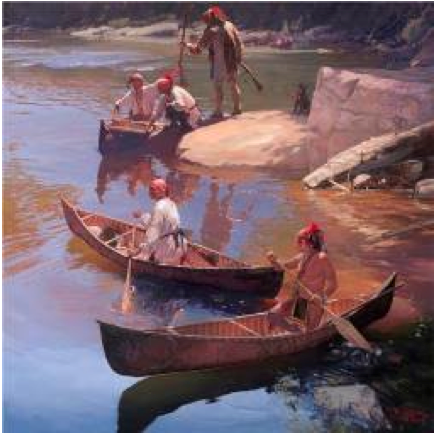
Fig. 18 Canoes in history
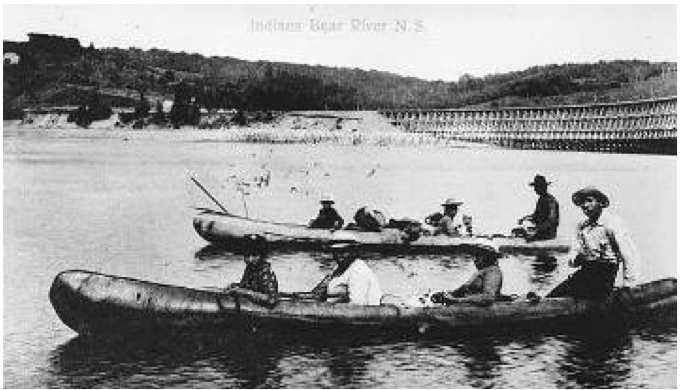
In June 1875, English businessmen Steven and Bradley descended the river Malše from Kaplice to České Budějovice from which place they continued further to Prague and down the River Elbe to Germany. It is the first trustworthy mention about canoeing in the Czech lands. A few similar events took place in the following decades but they were mostly done by foreigners. In August 1910, three canoes called Commager, Michigan and Rover were descending South Bohemian rivers Černá, Malše and Vltava. The crew of Commager were formed of J. R. Ořovský and J. Buchar. They were carrying all equipment such as tents, covers, things for cooking and food on the boats. This kind of river descending is called river camping. In 1912, J. R. Ořovský repeated the descend with his daughter.
Fig. 19 J.R. Ořovský and daughter
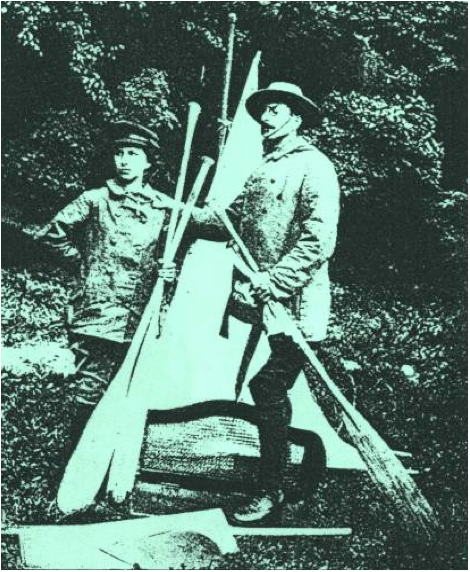
Fig. 20 J.R. Ořovský and daughter
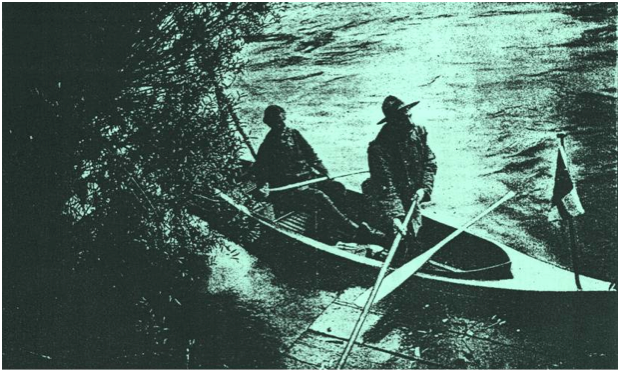
Canoeing and river descending has a long and famous tradition mainly on Vltava River in the leg between Český Krumlov and České Budějovice. In 1913, Czech Yacht Club in České Budějovice, Czech Yacht Club in Prague and Sculling Club Blesk Prague became the founding members of the Czech Royal Canoe Association.
Fig. 21 First page
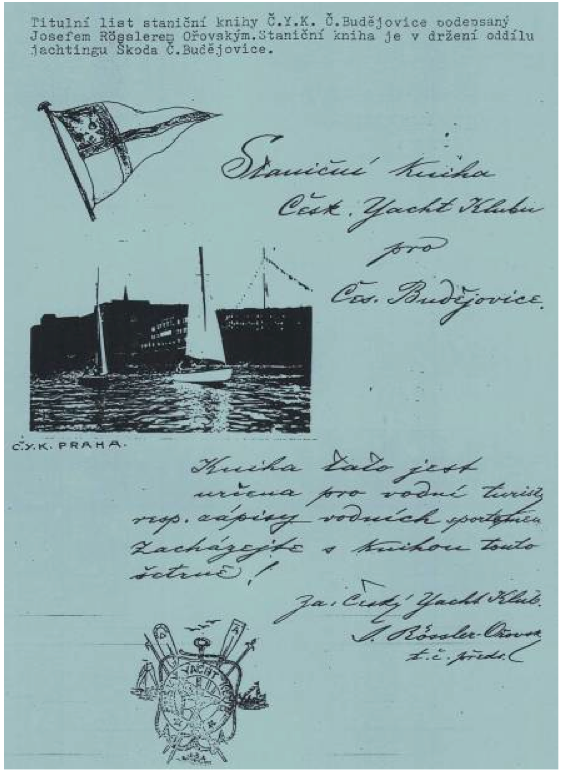
After the appearance of Czechoslovakia, canoeing started to develop very fast. River descending was developing, many famous camps were founded and first competitions organized mainly of a marathon character. The following legs were descended: Záhoří-Chuchle, České Budějovice - Praha, Cholín - Praha and many others.
As early as in 1925, Czech Canoe Association became the fifth member of International Canoe Federation. The First European Championship in canoeing took place in Prague in 1933. Prague hosted 58 competitors from 10 countries. A distance descend České Budějovice – Prague was also part of the program. The success of this Championship helped to include canoeing into the Olympic program in 1936.
Czech Hiking Club can be merited for promoting river descending. In 1924 Czech Hiking Club united 253 boaters. In 1926, a dock-yard with 100 boats was built in Bráník.
Fig. 22 The České Budějovice – Prague race
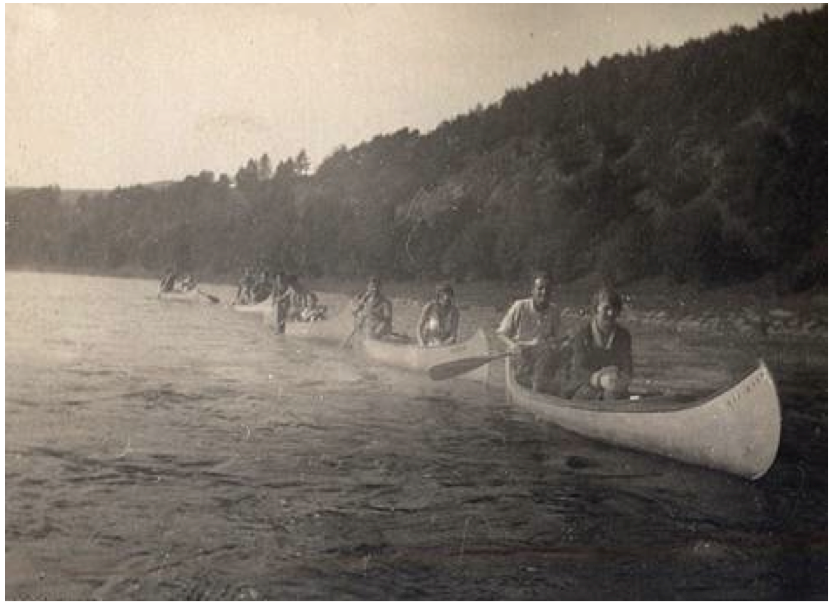
The České Budějovice – Prague race was very popular at that time. Its first year took place in 1922. It was the only race without stopping, the winners Richter and Engstler covered the route of 189 km in 27 hours 12 minutes. Their canoe weighed 105 kg.
The climax of the route was going through the sluice in České Budějovice with which event the race started from 1930s. It was originally a wooden raft sluice which was 6.5 m wide and 70 m long; the drop being 3.55 m. The bottom is equipped with rows of angular granite brims (a system by ing. Bazika).
Fig. 23 Sluice in České Budějovice
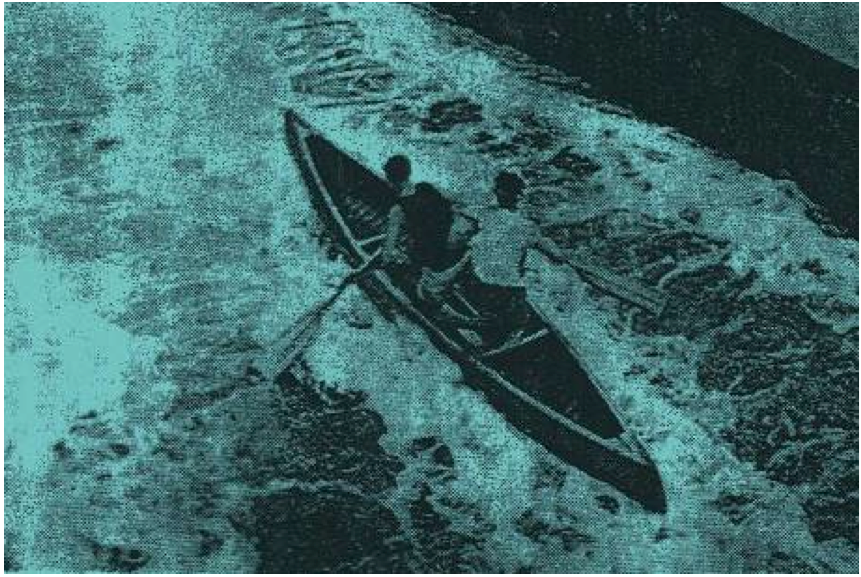
Altogether, 27 years of this race were organized. The route gradually changed in dependence on transformations of the Vltava valley. High difficulty and attractiveness of the original route were ensured by numerous rapids and mainly weirs. The most famous were Novomlýnská šlajsna or Žďákov. In 1950s, the boats which dominated the main categories were slightly adjusted for speed canoeing. In the figure on the bottom left, there is a group of boaters participating in the 25th year (1957) with the winning canoe team Polesný – Fuka leading the race. Absolute winners of the year Vambera – Holý on a double kayak are in the bottom right figure.
The last official year of this unique race took place in June 1959. The reason was that after creating Orlik reservoir, the route lost its original appearance completely.
Fig. 24 Vambera – Holý on a double kayak
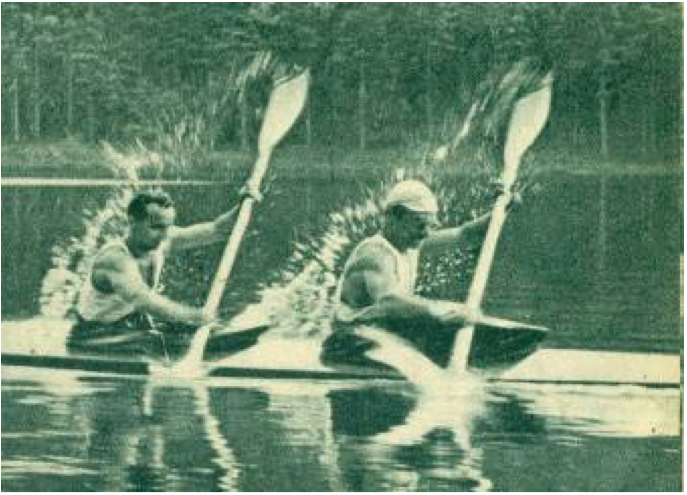
Fig. 25 The beginnings of water salom
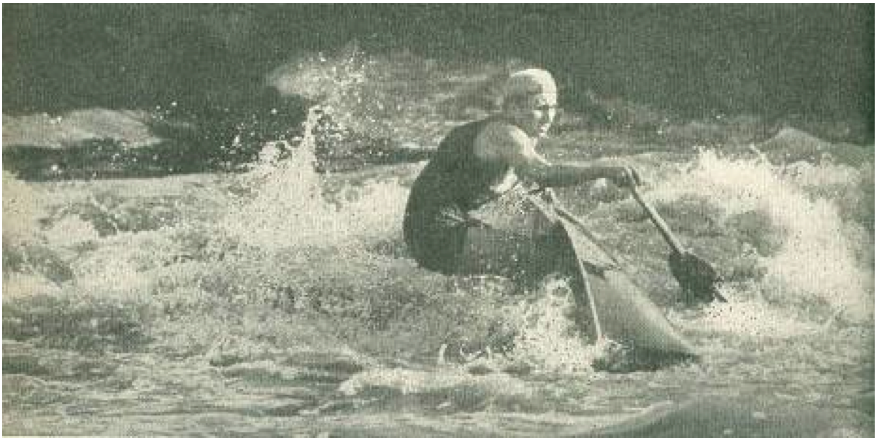
Fig. 26 The beginnings of water salom
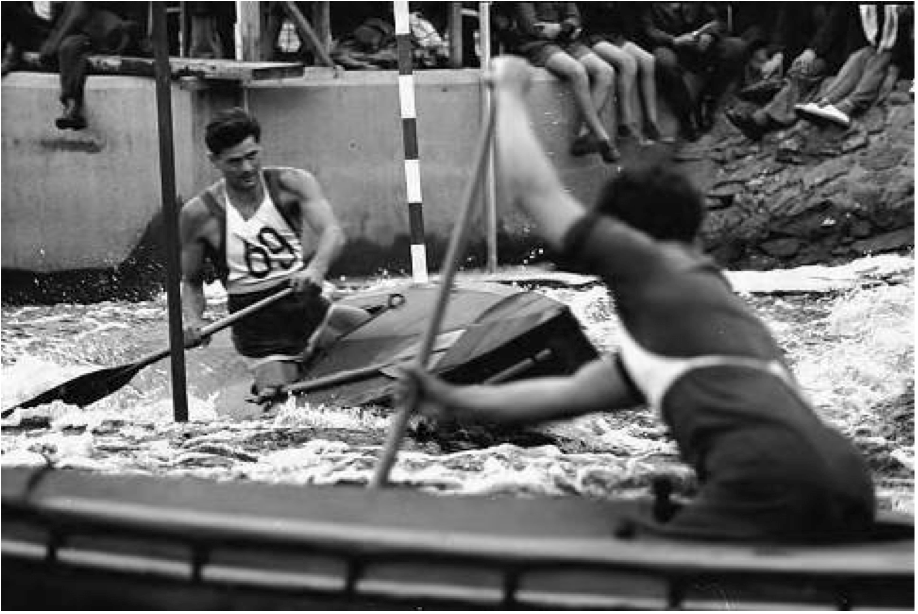
Shapes of Descend Canoes and their Use
The shape of each boat is a compromise between stability, facility and velocity. The boat designer either prefers one of the qualities or chooses a compromise. The influence of the shape of the boat on its operation can be manifested on the following two examples.
On the left, there is a typical long boat with straight keel, flat bottom or V-shape bottom. It is quite fast, it easily maintains direction, it is however difficult to turn and less stable mainly on waves. Such a shape is good for speed boats which are suitable for still or high running waters.
A boat with deflected keel, wide flat or round bottom are easier to control and turn and they are stable mainly on running waters. It is more resistant against side currents but it is slower and it is harder to maintain direction. Therefore this kind of boat draws on original slalom boats in which the crew sat in a classic way, i.e. far from each other. It is suitable for running low waters (open canoes according to design most often up to WW III) on which often sudden changes of direction are required. Longer trips on still waters can be very tiring on slalom canoes.
Fig. 27 Ship with a straight keel
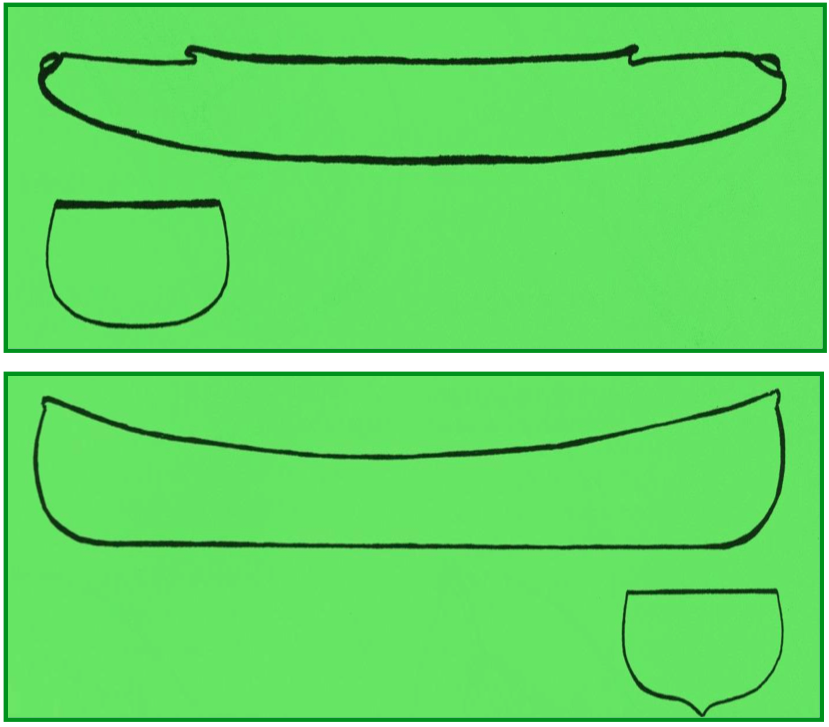
Examples of different descend canoes of laminate or sandwich design. Upper left – s Czech legend called Vydra; bottom right multi-seat canoe.
Fig. 28 Examples of different descend canoes of laminate or sandwich design
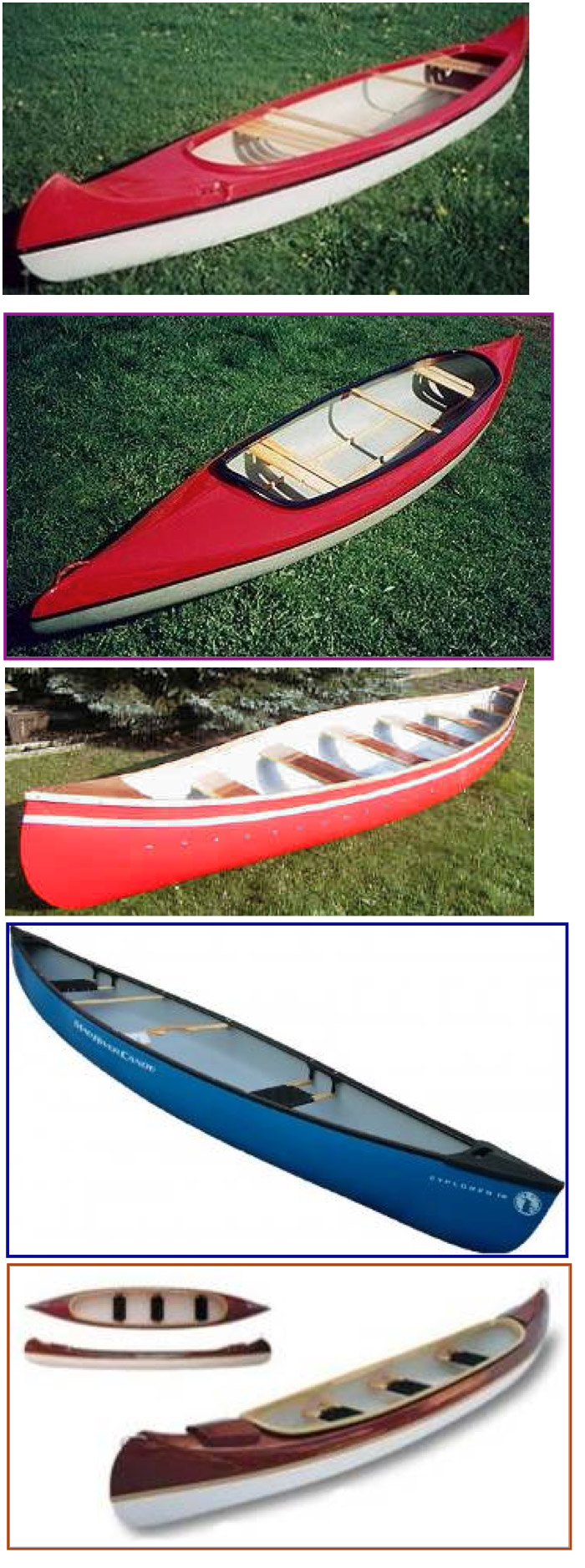
However, at present boats made of plastics are very popular due to their endurance. Their shapes and operation properties differ to a great extent.
Fig. 29 Boats made of plastics
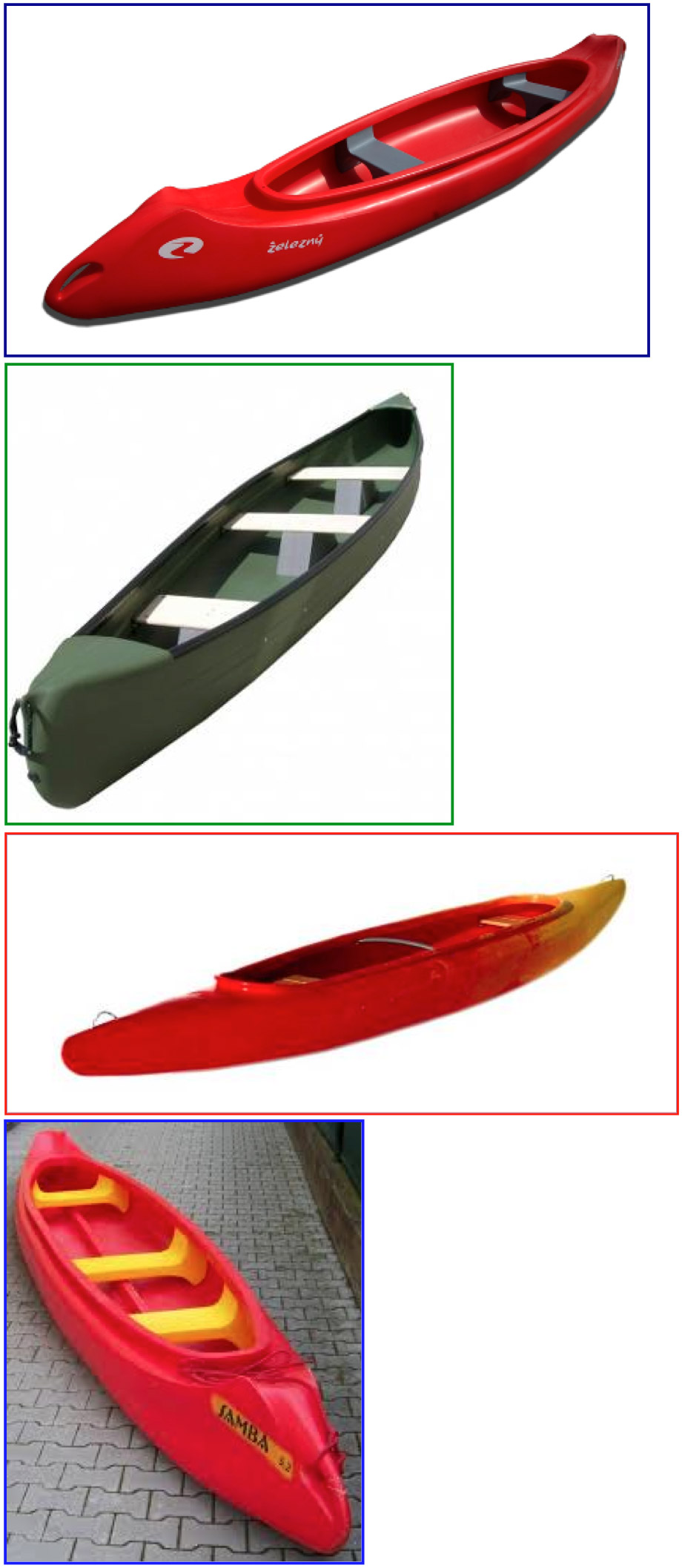
Inflatable canoes are popular as well. Their design, determination and operation properties again differ a lot. However, making use of their stability on Czech low waters can be questioned. The rest of the properties and lower endurance are more of a disadvantage. Their major advantage is easy transport and relatively high safety. When packed, inflatable boats are of about 10 times smaller volume than comparable solid boats.
Fig. 30 Inflatable canoes
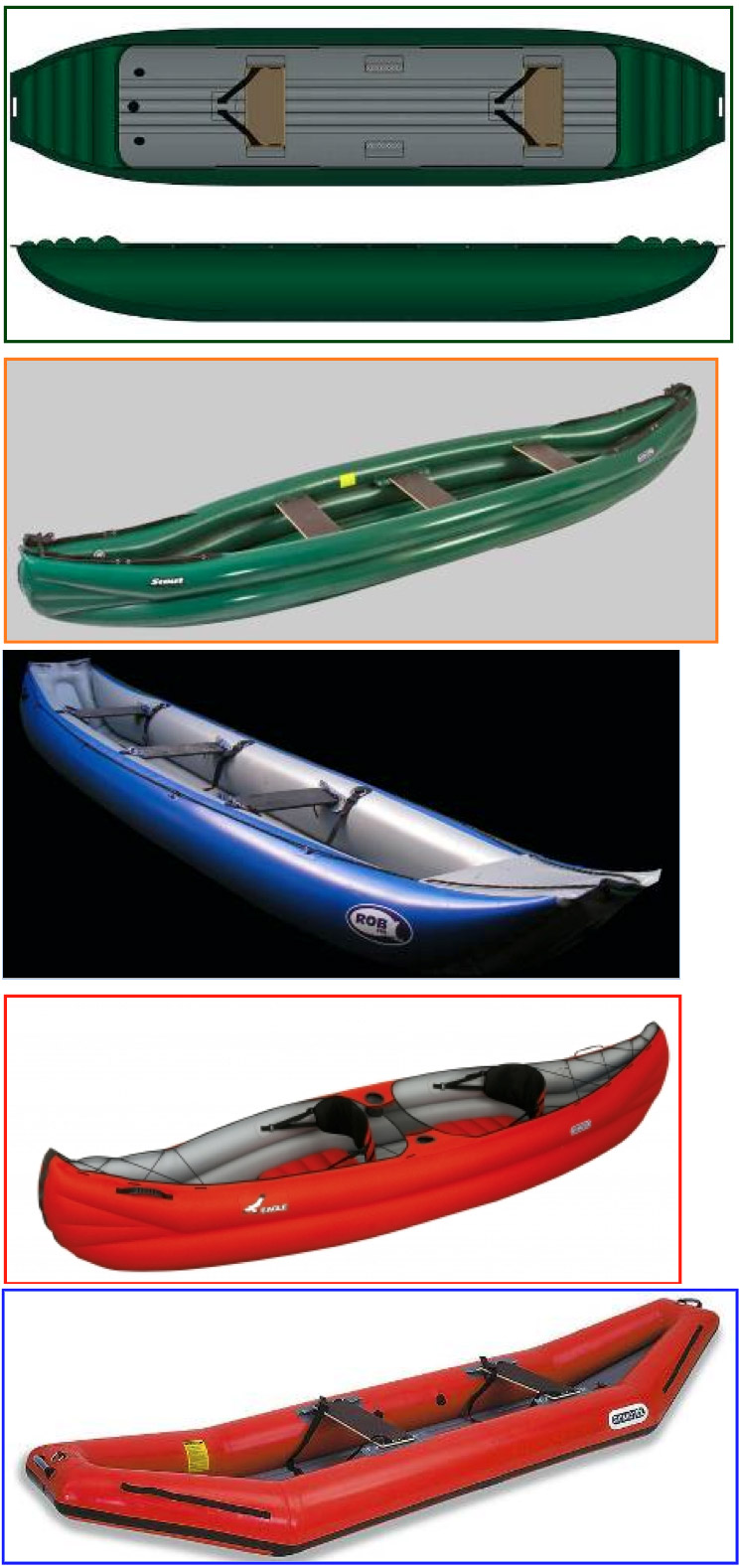
Shapes of closed boats – kayaks
Generally, there are only two basic shapes of closed ships suitable for wild waters; both of them draw on the shape of slalom boats. It took a long time before they have developed into their current appearance. Wild water slalom was of the main influence on the appearance and design of the boats.
On the left, there is a shape characteristic by round shapes, mainly in combination with big displacement and stability. Boats of this type are less sensitive to technical mistakes of the paddler. They are suitable for technically less skilled paddlers.
The shape of the boat depicted on the right ensures greater facility. Boats of this shape are more lively but at the same time more sensitive to the paddler’s mistakes. Thus, they are suitable for advanced paddlers.
Fig. 31 Closed kayaks
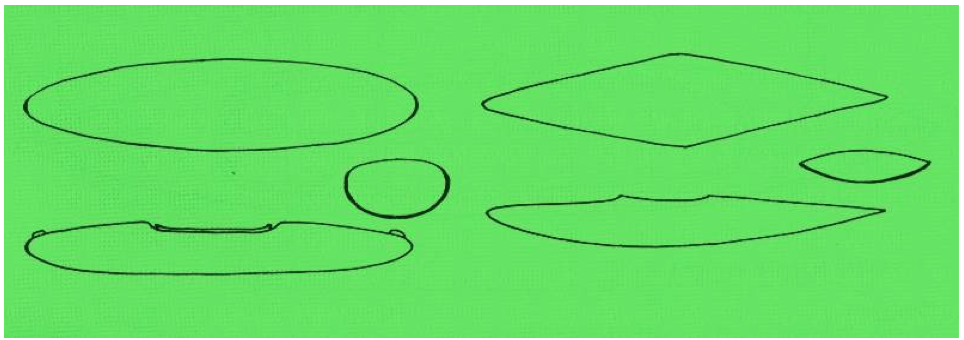
Most manufacturers offer both classic kayaks and kayaks suitable for extreme water or rodeo. They also offer lake or sea kayaks.
Fig. 32 Kayaks for extreme water or rodeo, lake or sea kayaks
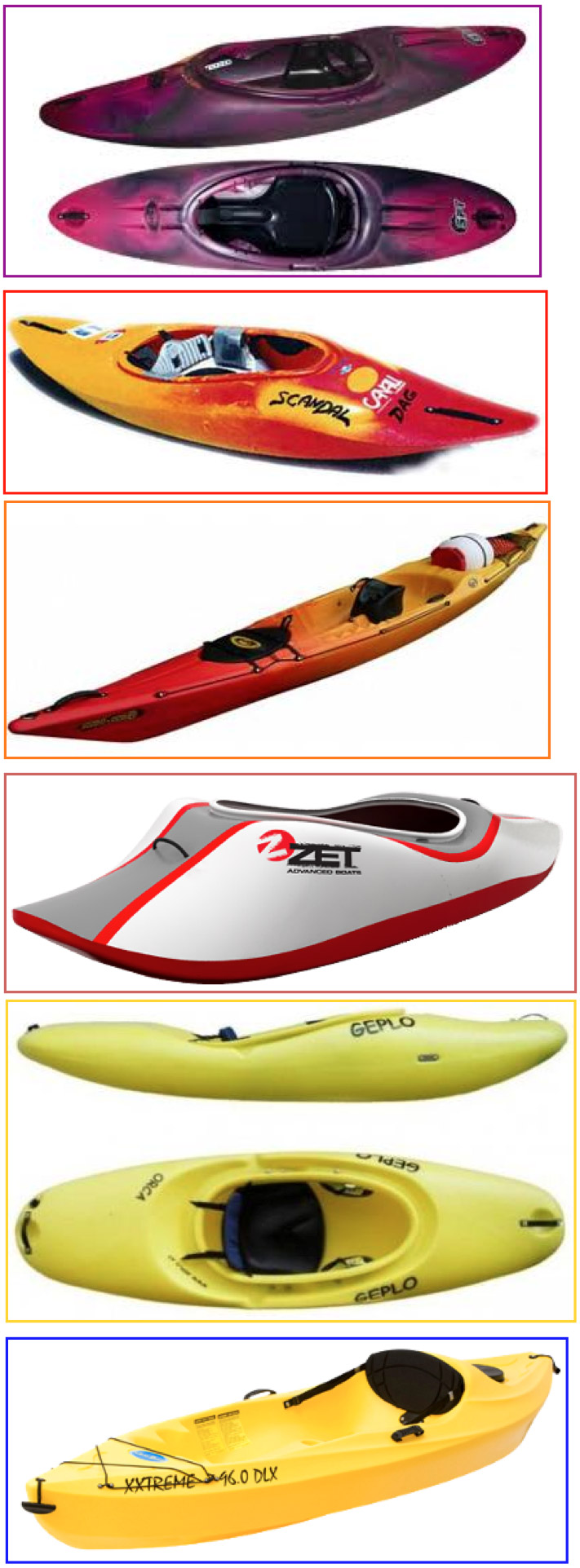
Rafts
Inflatable sports boats designed for a larger number of people are called rafts. Their capacity is usually between 4 and 12 persons. They are suitable for more extreme waters but they can also be used commercially. They are mostly controlled by a bit longer canoe paddles, however sometimes sculls or engine are used. Rafts must conform to the strictest safety requirements out of all inflatable boats. Countries where there are good conditions for extreme rafting have strict rules for both safety while selling rafts and operating them.
Fig. 33 Raft with closed and open stern
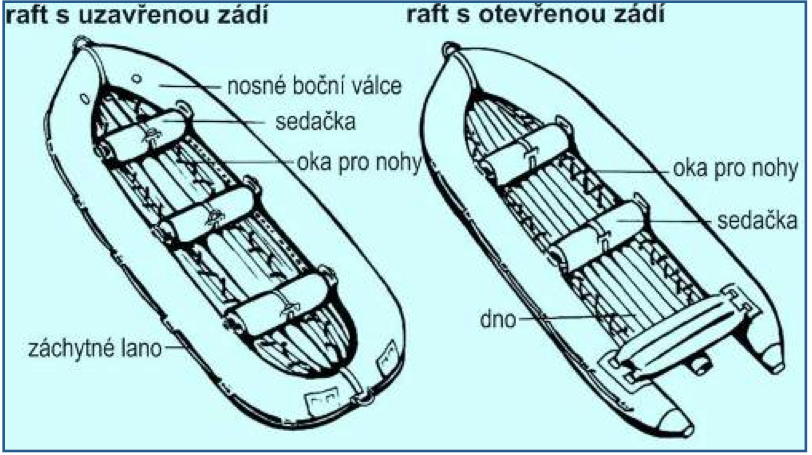
The simplest models have closed design and solid bottom (classic inflatable boat). If filled with water (e.g. in bigger rapids), they are very difficult to control.
Rafts with open stern are designed in such a way to allow the water flow off the boat through the stern. The stern is either fully open or, at more expensive models, divided with a bar with a flow-out funnel. Such rafts are suitable for less demanding rivers due to their smaller twist rigidity.
Expensive top professional expedition rafts are designed with closed stern and permeable bottom. There is an auto-drain bottom (or there is only a net bottom sometimes). This enables the water to flow off easily.
Examples of modern rafts
Fig. 34 Modern rafts
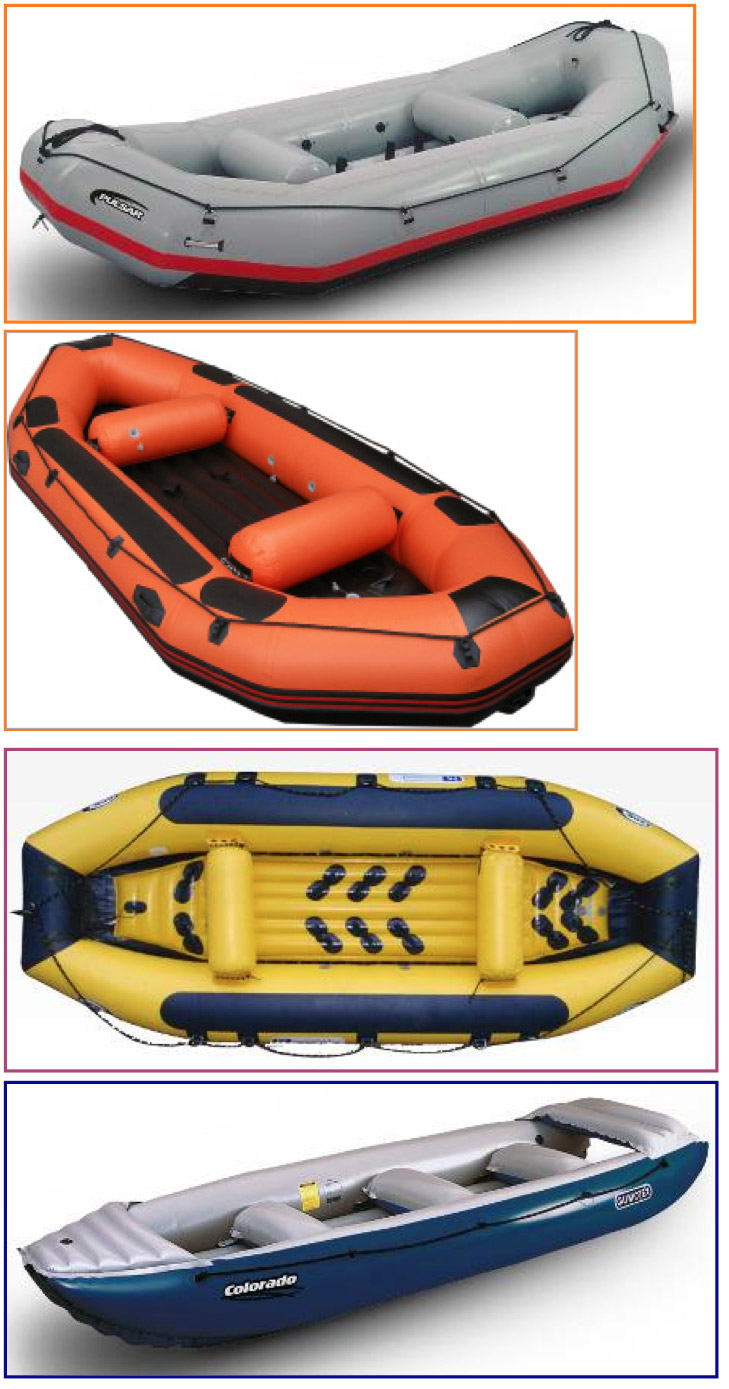
However, even an expedition raft can get capsized.
Fig. 35 Capsized expedition raft
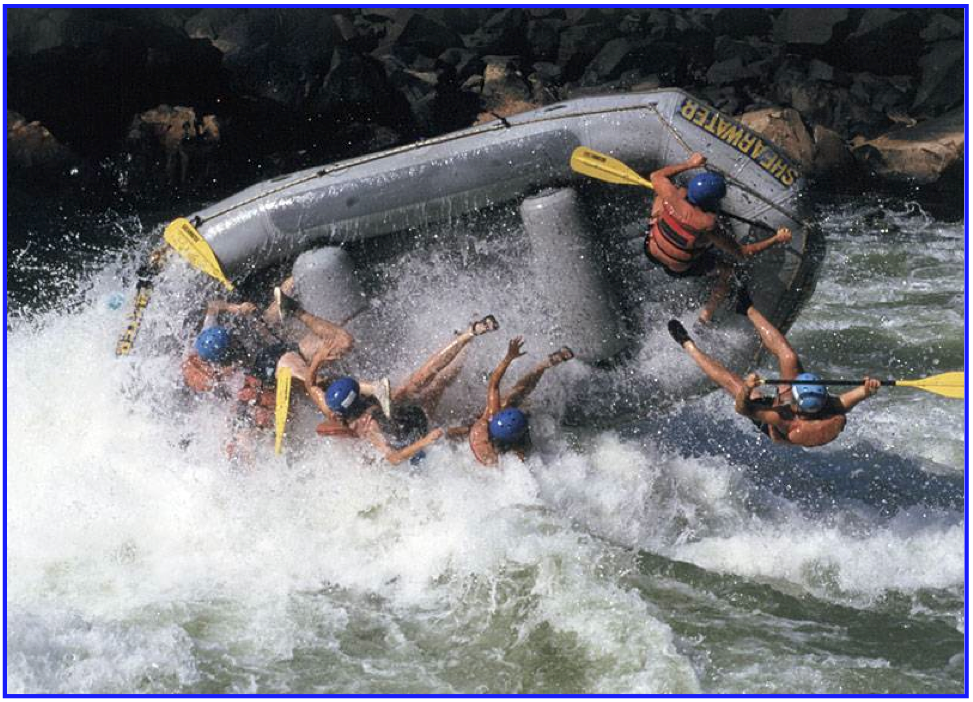
Water rodeo, an extreme branch of canoeing, is becoming more and more popular.
Modern rodeo boats differ from classic ones in shape, design and equipment.
Fig. 36 Modern rodeo boats
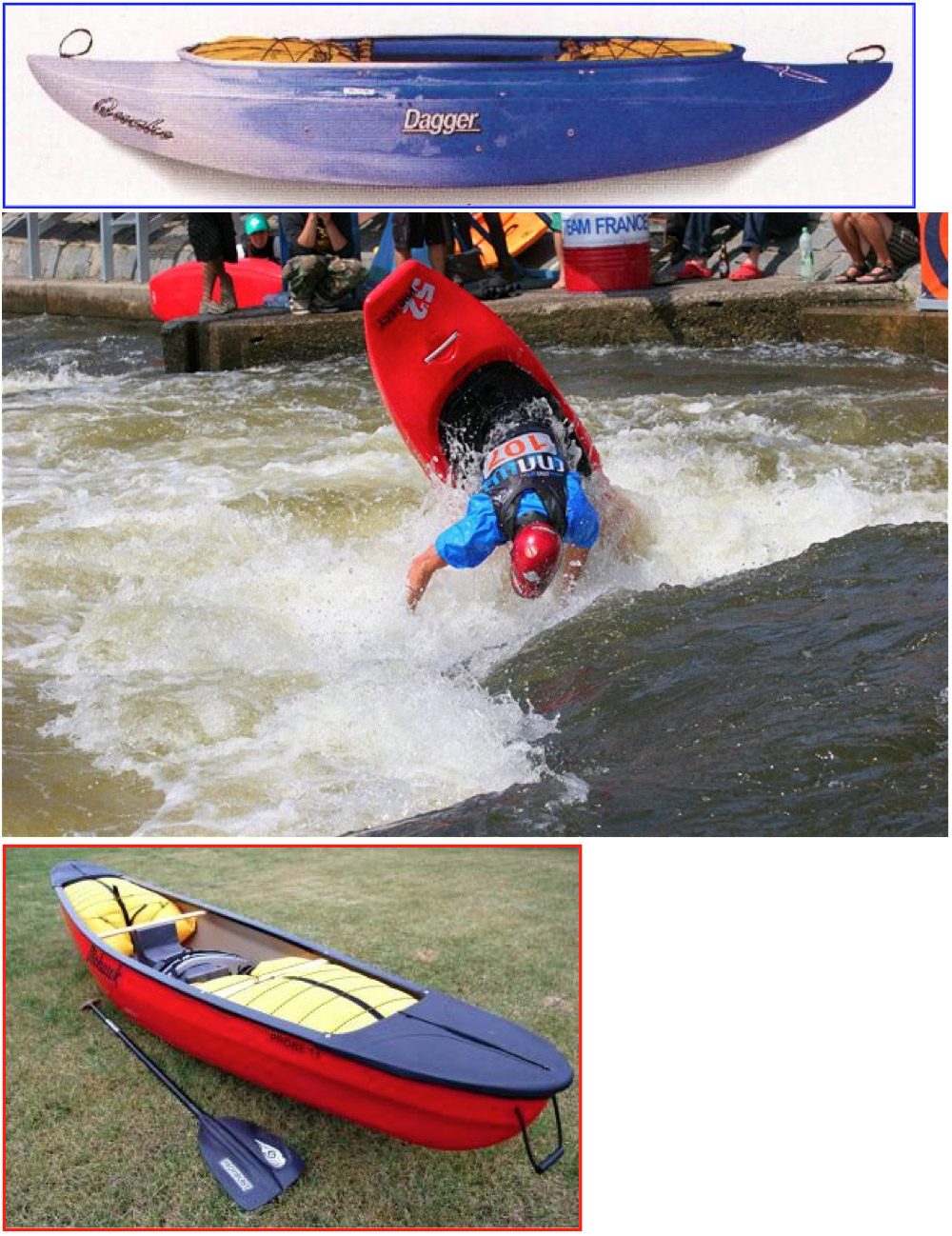
Canoe (single blade) paddles
Canoe paddles consist of the upper grip, the loom and the blade. Paddles are made of different materials. Often various materials are combined. Material is chosen according to the purpose of the paddle and requested durability and price. On more expensive paddles, there is a soft mass on the places where the paddle is held, which silences hits and prevents slipping.
At present, most commonly used paddles have a duralumin pipe covered with plastics as the loom and the blade made of stroke-resistant plastics. If other materials are used, the blade is equipped with outer or inner iron fitting.
The length of the paddle should be such that it ends between the shoulder and the chin. In rafting, longer paddles are used.
Kayak (double blade) paddles
Kayak paddle is formed of loom with blades on both ends. The cross-wind axes of the blades must be turned against each other by 75-90˚. The loom should be firm enough to transmit force of the stroke on the blades in the correct direction but at the same time it should be flexible enough to silence hits as much as possible. Nowadays, the looms of more expensive kayak paddles are often of complicated shapes. The intersection of the loom at the spot where it is held should be oval. Oval intersection at the spot of the grip (or at least lugs on the loom) makes the control of the blade easier during a stroke, mainly during steering strokes; it also assists in reaching correct position of the blades while performing Eskimo turns.
Kayak paddles are divided into left and right depending on the hand in which the paddler holds the paddle firmly. However, left paddles are very rare these days.
The design of the blades is similar to the design of canoe paddles. However, the shapes are very much different.
Recommended length of kayak paddles:
Body height paddle length for wild waters paddle length for river descending
160 cm 180 cm 190 cm
170cm 190 cm 210 cm
180cm 200 cm 215 cm
190 cm 205 cm 230 cm
Fig. 37 Kayak paddles
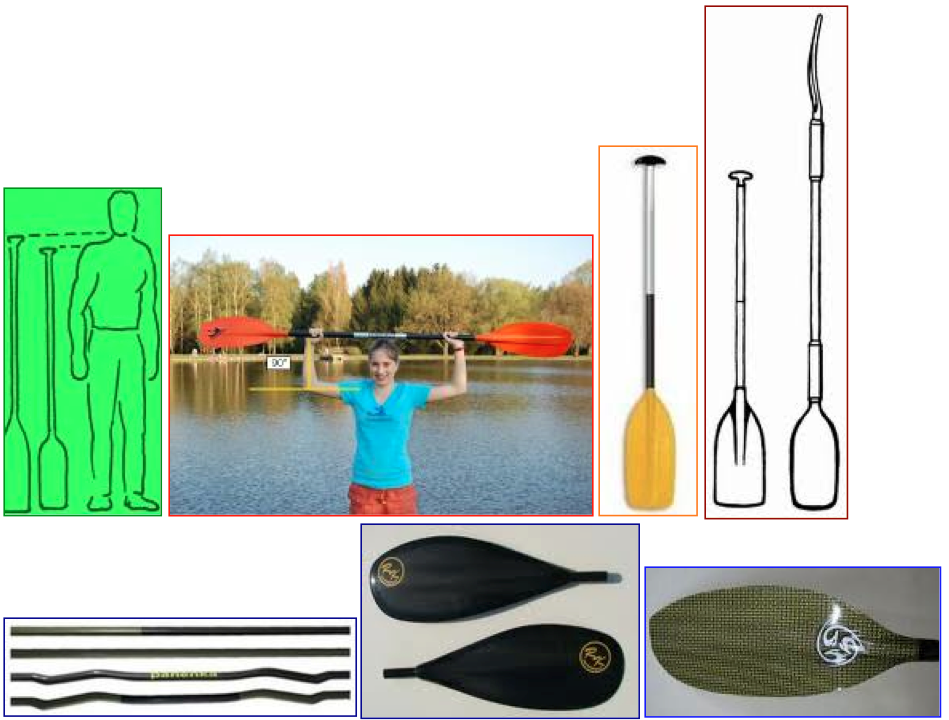
Classification of water courses according to difficulty:
Running water – abbreviated ZW (from German zahm Wasser)
ZW A – still or mildly running water up to the speed of 4 kph; the speed of the current is slower that regular walking speed.
ZW B – mildly running water, the speed of the current is 4-6 kph; it equals the speed of walking. It is possible to paddle upstream.
ZW C – the speed of the current is over 6 kph. It requires much effort to paddle upstream. However, there are no rapids.
Wild water – abbreviated WW (from German wild wasser)
WW I – easy. Small rapids with regular low waves appear from time to time. Paddling route is easy to determine.
WW II – semi-difficult. More frequent regular rapids and regular whirlpools, easy countercurrents.
WW III – difficult. Frequent rapids with high irregular waves, whirlpools and countercurrents. Paddling route is not always easy to determine.
WW IV – very difficult. Long legs with rapids with high irregular waves, difficult crests and holes. Big rapids and countercurrents. It is difficult to determine paddling route; it is recommended to have a look at the river leg from the bank.
WW V – particularly difficult. Long continuous rapids with difficult irregular crests, sloping holes, very strong whirlpools and countercurrents. Frequent rocks under water. The speed of the current is extremely high. It is necessary to have a look at the route before.
WW VI – extremely difficult. They are on the edge of descendability. This type can also be additionally marked with – or +.
The following factors are important when judging the difficulty of the water course:
1) River drop (given in ‰)
2) Flow rate (the amount of water per a unit of time in cubic meters per second)
3) River basin characteristics
Water courses marked ZW a – ZW C can be descended by complete novices.
River legs marked WW I – II can be descended by paddlers who mastered basic skills of boat control. They can be descended in open boats.
River legs marked WW III are not recommended for open boats. Paddlers should be equipped with a helmet and life vest.
River legs marked WW IV – VI are meant only for advanced paddlers with professional accessories and equipment.
Safety in canoeing and river descending is affected by three basic factors:
Fig. 38 Safety graph
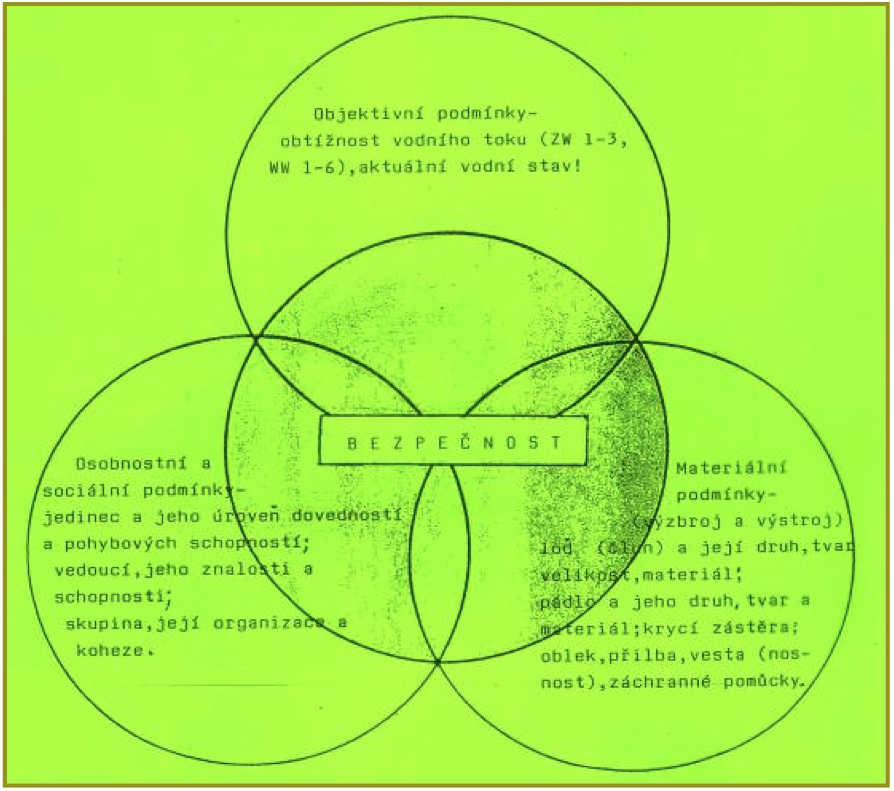
Experienced boaters are able to descend even extreme waters
Fig. 39 Extreme waters
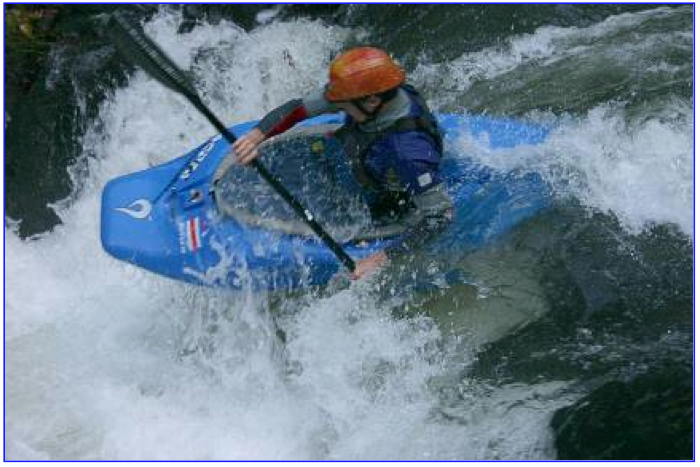
Fig. 40 Extreme waters
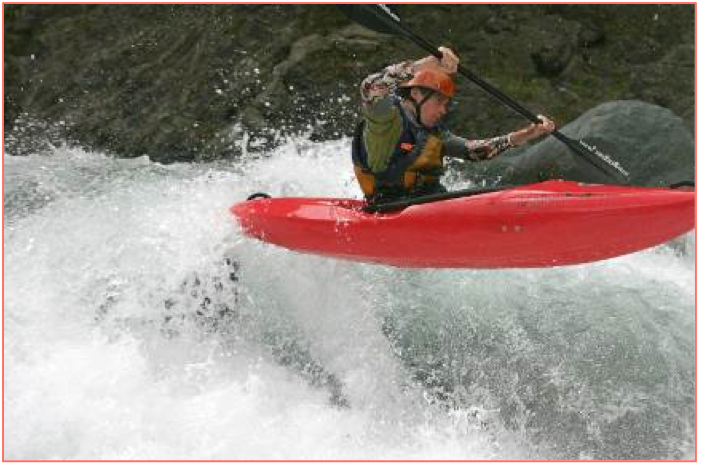
In the context of Czech canoeing, the most dangerous, from the point of view of a boater, are inappropriately built small waterworks and, mainly when the water is high, sluices with stilling pools under which dangerous holes appear.
Fig. 41 Sluice with stilling pool
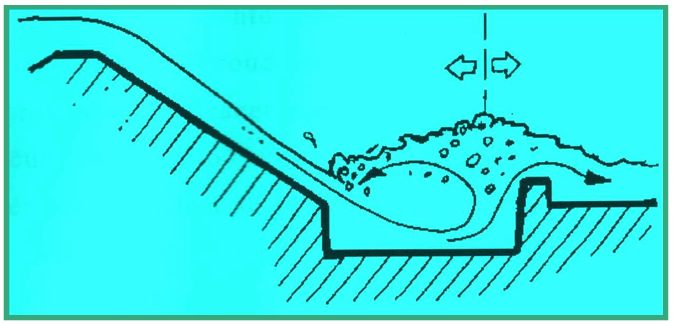
Fig. 42 Stilling pool
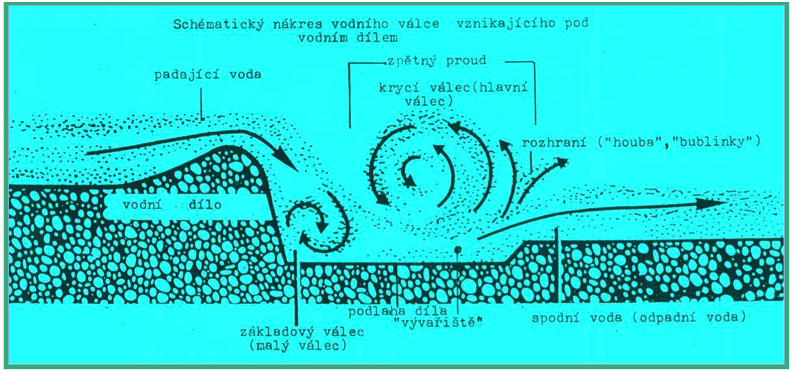
Below is the so-called Small sluice on the River Malše in České Budějovice during Flood Stage I. A hole of this size is not descendable and it is not possible to get out of it without assistance from the bank.
Fig. 43 Sluice on the River Malše
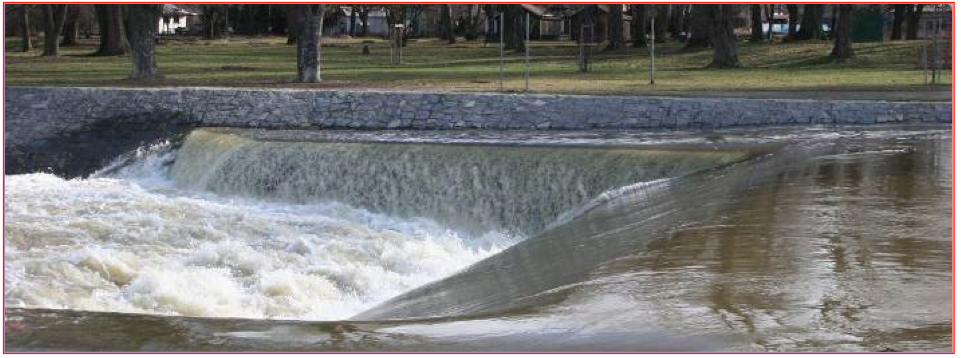
Basic technique of canoeing and river descending –
canoe forward stroke in C2
Fig. 44 Canoe forward stroke
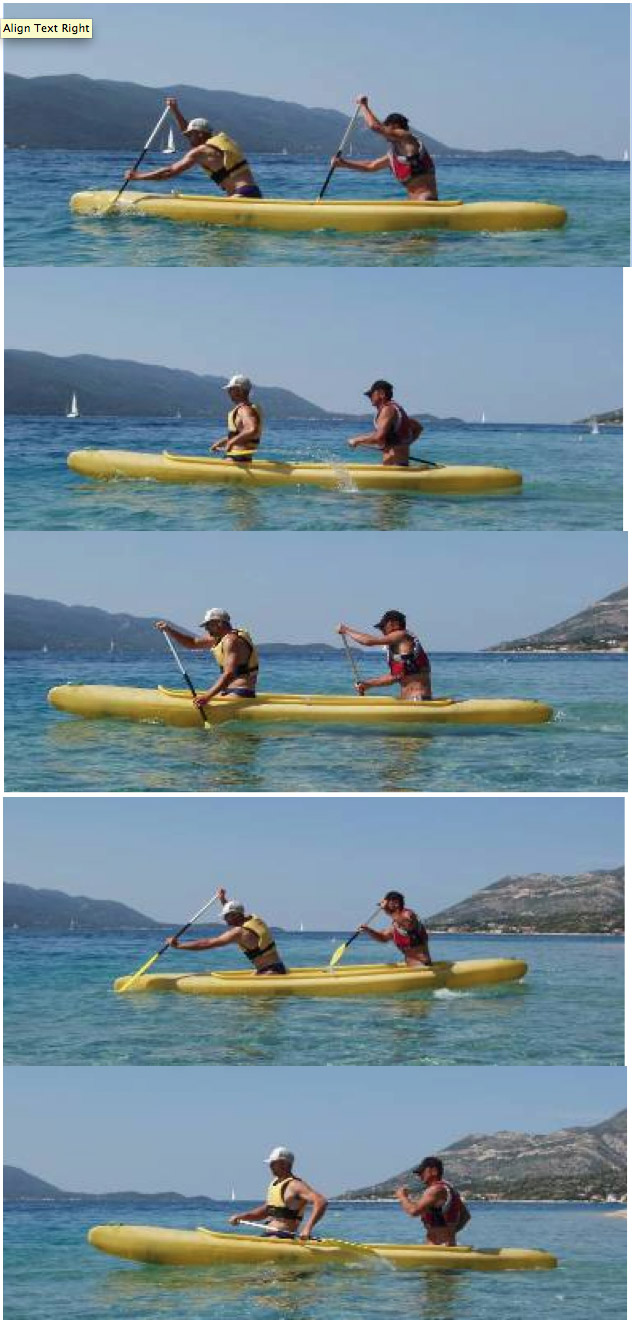
Basic technique of canoeing and river descending –
canoe forward stroke in C2
Fig. 45 Canoe forward stroke
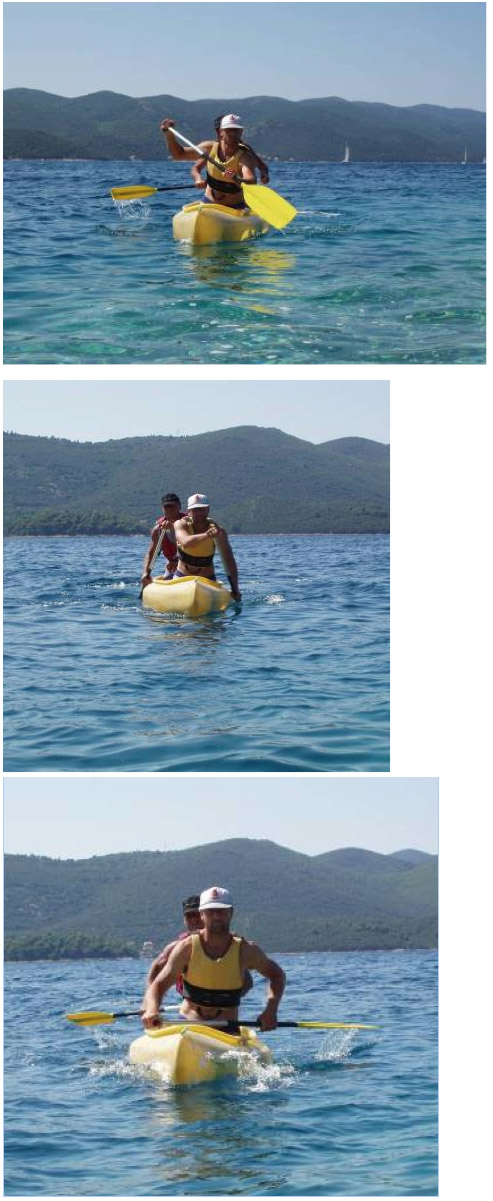
Basic technique of canoeing and river descending –
brace on the side of the bowman in C2
Fig. 46 Brace on the side of the bowman
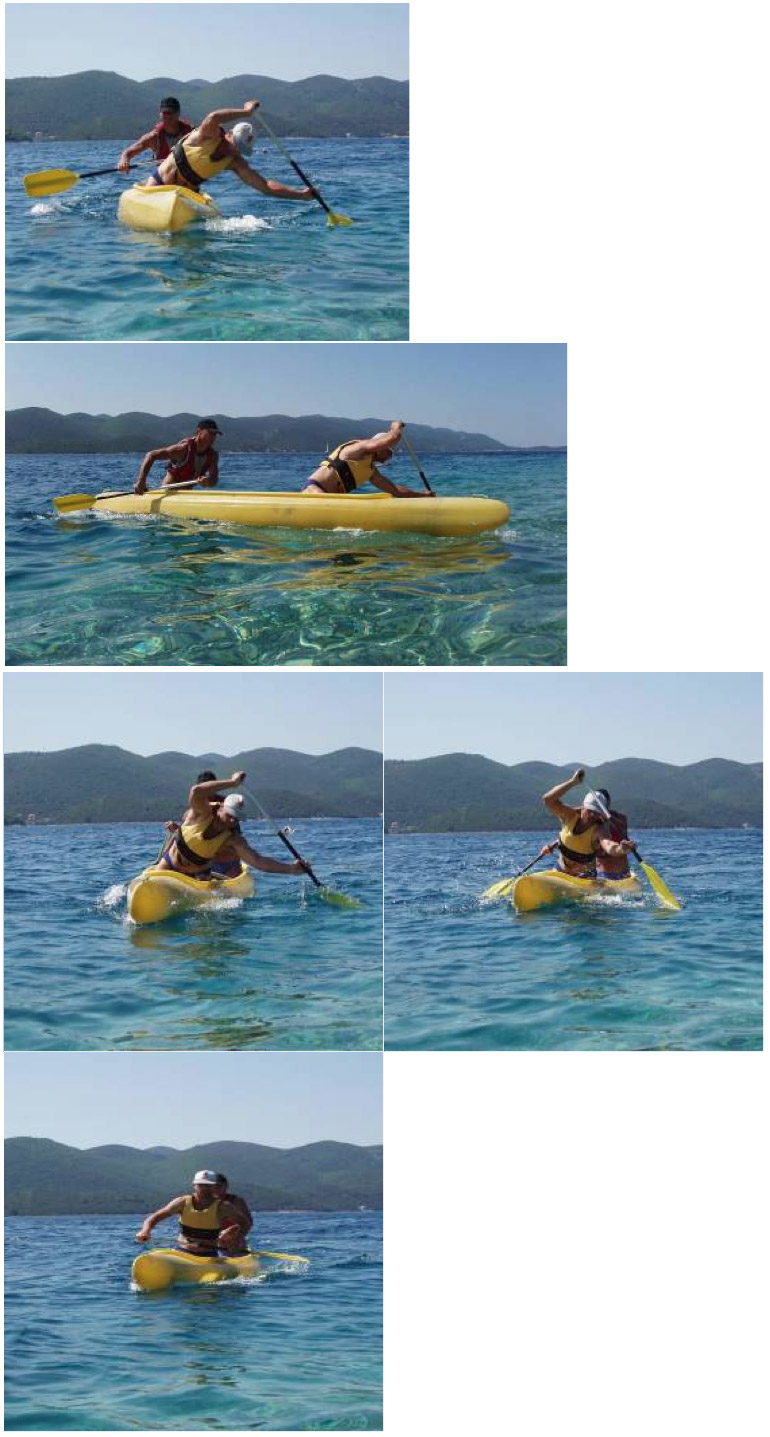
Basic technique of canoeing and river descending –
bowman’s backhand brace in C2
Fig. 47 Bowman’s backhand brace
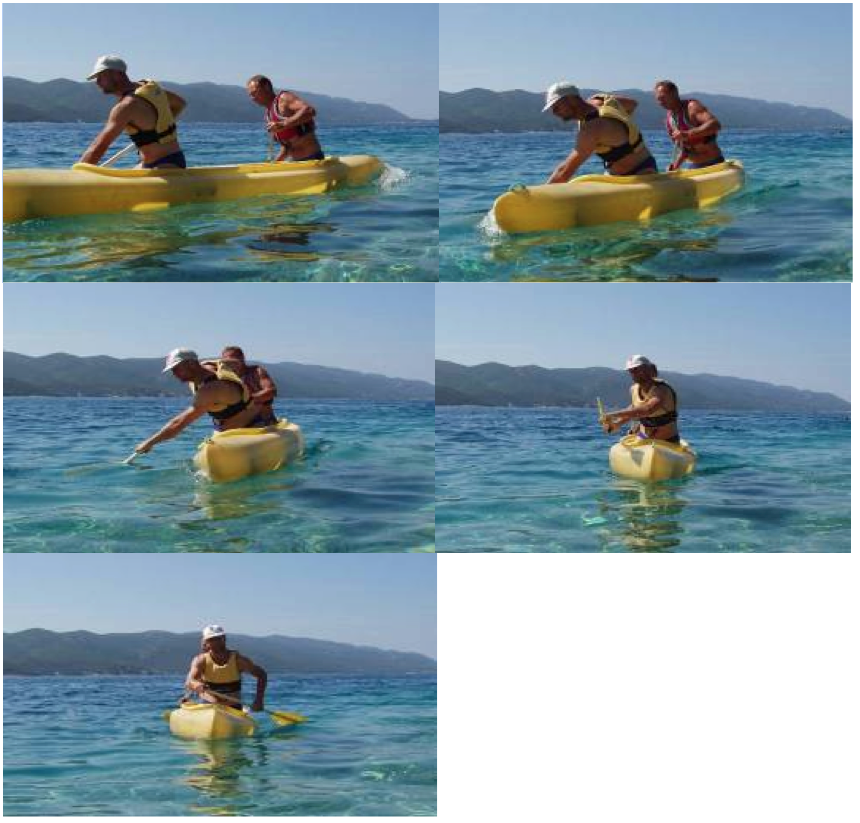
Basic technique of canoeing and river descending –
basic canoe forward stroke in C1
When singling in a non-professional boat and if allowed by the boat’s design, opposite sitting position is recommended (kneeling while being supported against the front seat). The boat is thus better longitudinally balanced and is better maneuverable than when sitting in front of the back seat – see bottom left.
Fig. 48 Basic canoe forward stroke
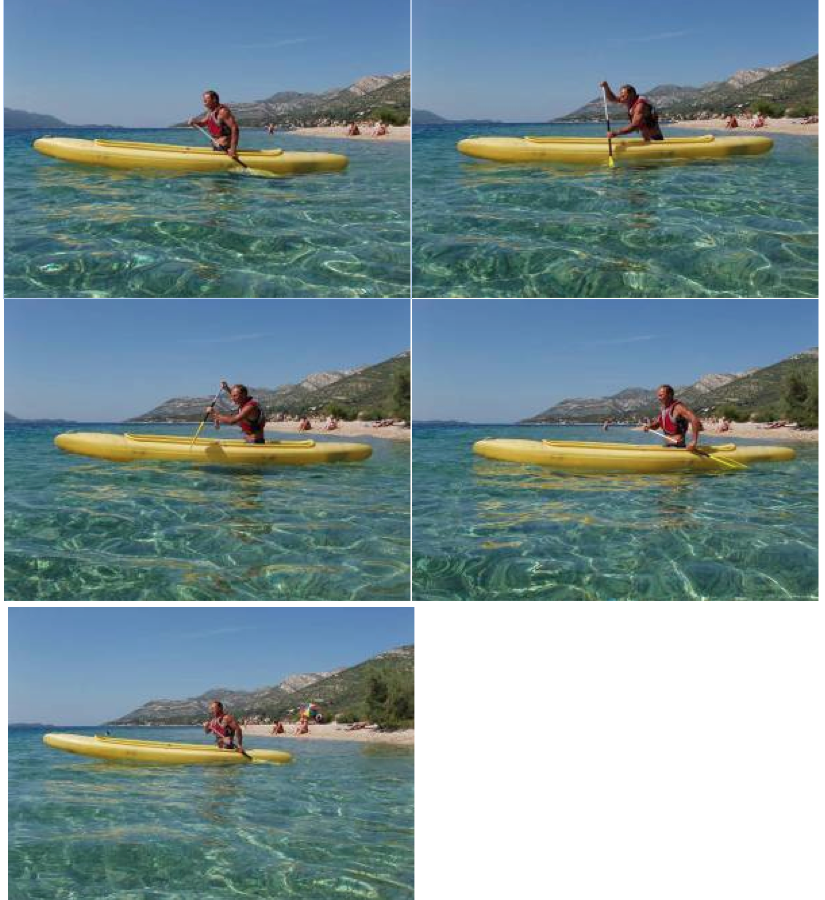
Basic technique of canoeing and river descending –
brace in C1
Fig. 49 Brace in C1
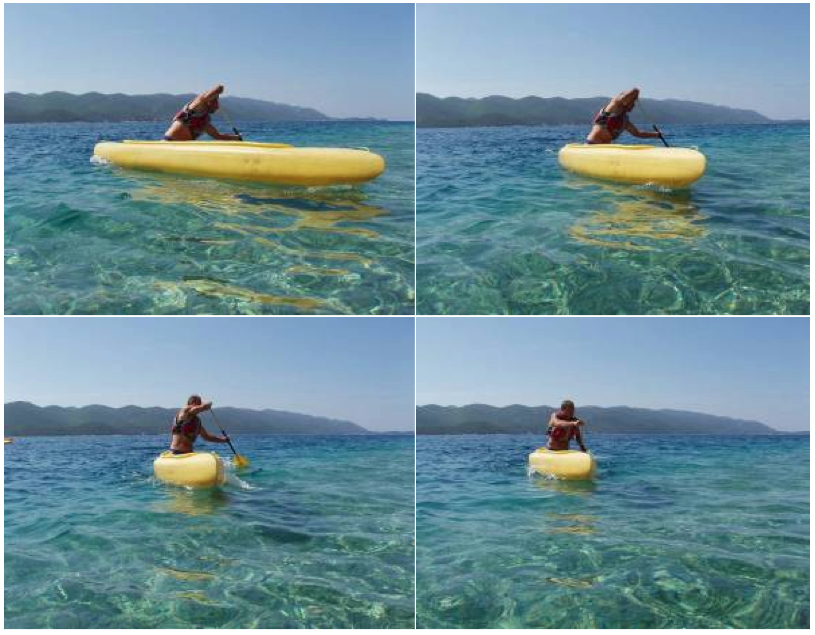
Basic technique of canoeing and river descending –
backhand brace in C1.
Fig. 50 Backhand brace
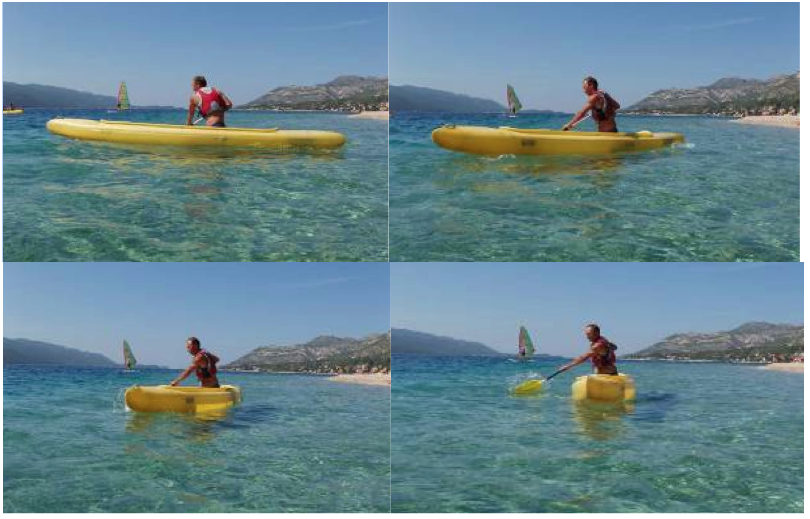
Basic technique of canoeing and river descending –
going forward in a kayak
Fig. 51 Going forward in a kayak
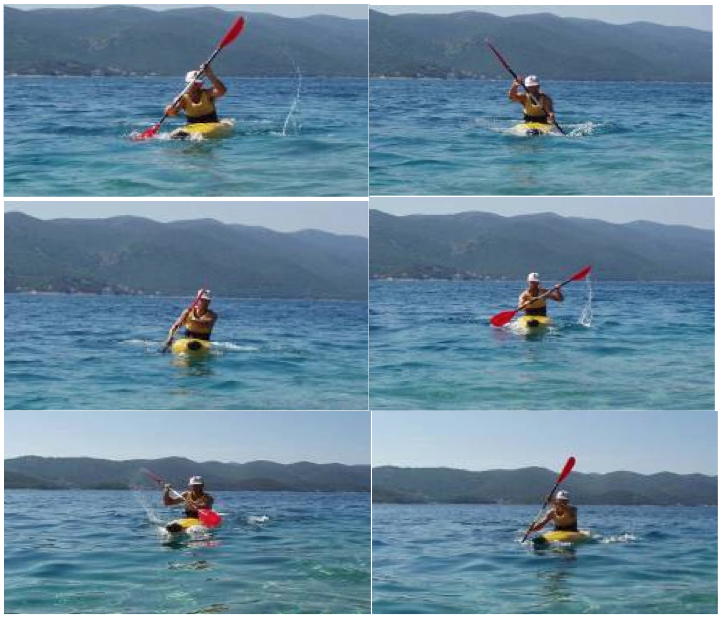
Basic technique of canoeing and river descending –
brace in a kayak
In a kayak, the brace is performed in the same way on any side.
Fig. 52 Brace in a kayak
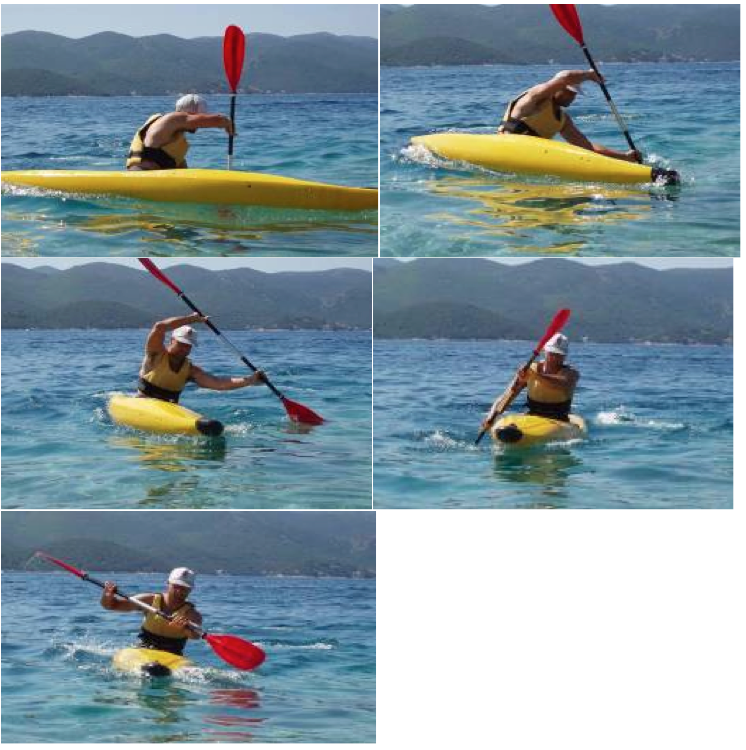
Eskimo turn performed in a lever way in a kayak
Fig. 53 Eskimo turn performed in a lever way in a kayak
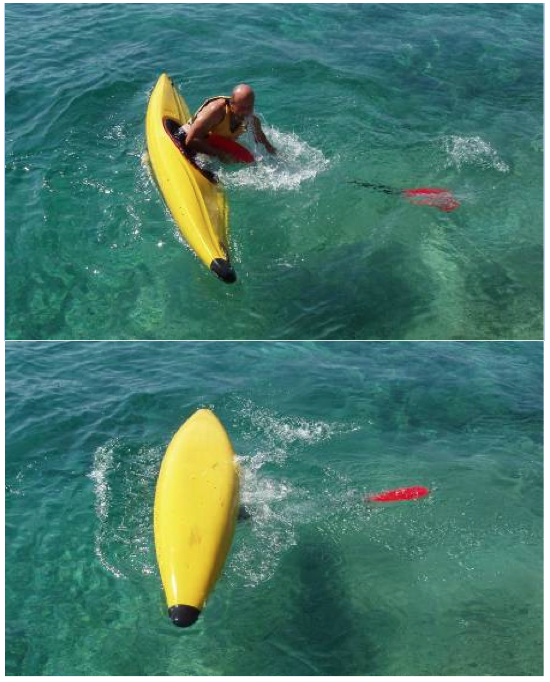
Eskimo turn in a kayak – so-called screw
Fig. 54 Eskimo turn in a kayak – so-called screw
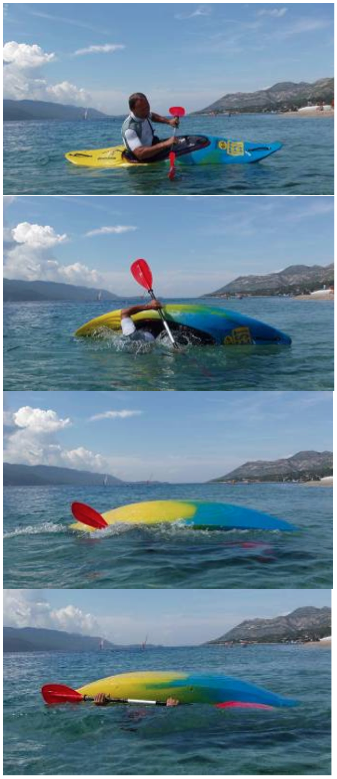
Keywords:
river descending, canoe, kayak, raft, Stevens, Bradley, basic canoe technique, Eskimo turn-screw, Eskimo turn performed in a lever way in a kayak, brace in a kayak, going forward in a kayak, backhand brace in C1, brace in C1, basic canoe forward stroke in C1, bowman’s backhand brace in C2, brace on the bowman’s side in C2, canoe stroke forward in C2, level of difficulty of running and wild waters, hole, running waters – ZW marking, wild waters – WW marking